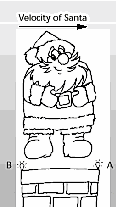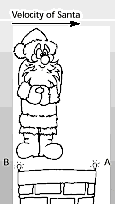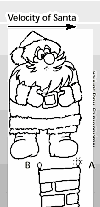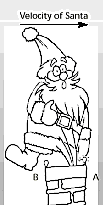I hope this makes you laugh a little.

Santa at Nearly the Speed of Light
by Arnold Pompos, Purdue University, and Sharon Butler, Office of Public Affairs
About this time of year, inquisitive children of a certain age begin to question whether Santa is real. After all, Santa has a major delivery problem. There are some 2 billion children in the world expecting Christmas presents. Assuming an average of 2.5 children per household, then, Santa has to visit about 800 million homes scattered about the globe.
The distance Santa has to travel can be estimated from the following. First, while the surface area of Earth is about 10
14 square meters, only about 30 percent of that is land mass, or about 0.3 x 10
14 square meters. Second, we’ll assume, for simplicity’s sake, that the 800 million homes are equally distributed on this land mass. Dividing 0.3 x 10
14 by 800 million gives 4 x 10
4 square meters occupied by every household (about six football fields); the square root of that is the distance between households, about 200 meters. Multiply this by the 800 million households to get the distance Santa must travel on Christmas Eve to deliver all the children’s gifts: 160 million kilometers, farther than the distance from here to the sun.
Thanks to the rotation of the earth, Santa has more time than children might initially think. Standing on the International Date Line, moving from east to west and crossing different time zones, Santa has not just 10 hours to deliver his presents (from 8 p.m., when children go to bed, until 6 a.m., when they wake up), but an extra 24 hours— 34 hours in all.
Even so, Santa’s task is daunting.
Now, some have guessed that Santa accomplishes his task by traveling at a speed close to that of light—let’s say, 99.999999 percent of the speed of light. By traveling that fast, in fact, Santa can deliver all his presents in just 500 seconds or so, with plenty of time left over (the remainder of the 34 hours) to polish off the cookies the children have left him on their kitchen tables.
There are certain consequences, however, of Santa’s traveling at this frantic pace. For example:
First, children may not be able to see Santa racing across the dark night sky, but they may be able to see a trail of light caused by Cerenkov radiation, a phenomenon created when charged objects travel faster than the speed of light (which they can do in transparent media, but not in a vacuum). Since the basic component of our atmosphere is nitrogen, light is slowed to 99.97 percent of its usual speed of 300,000 kilometers per second. Santa travels faster than this and undoubtedly is charged; as a consequence, then, he will emit visible photons. (Unfortunately, that light will be obscured by the light caused by the friction created when Santa rushes through the atmosphere. Also, Santa might roast in all this heat, but we’ll presume that Santa’s sleigh, like space capsules, has special protective shielding.)
Second, children will notice that as Rudolph, Santa’s lead reindeer, is rushing toward their homes, his nose is no longer red. The color depends on just how fast Rudolph is moving, turning yellow, then green, then blue, then violet, and finally turning invisible in the ultraviolet range as he accelerates to higher and higher speeds. This change in color is a well-known phenomenon, called the Doppler shift, which astronomers take advantage of to figure out the speeds with which the stars and galaxies in our expanding universe are moving with respect to us; from that information, the distances to these celestial objects can be deduced. Using the accompanying table, children can determine how fast Rudolph is traveling by noting the color of his nose.
One worry Santa has is whether, with his irremediable girth, he’ll be able to squeeze into all those chimneys. Traveling at nearly the speed of light makes the problem worse, because Santa gains mass (his kinetic energy adds to his mass, as Einstein’s famous E = mc
2 attests). Children believe that Santa will easily fit in the chimney, because from their frame of reference, even though Santa is heavier, he has contracted. From Santa’s frame of reference, though, the chimney is narrower than Santa is.
But children need not fear. The theory of relativity assures us that Santa will fit (see figure 4), and their packages will be delivered on time.
Children might also wonder why Santa never seems to age. From year to year, he retains his cherub face and merry laugh, his long white beard and his round belly that jiggles like a bowlfull of jelly. The fact is that for objects traveling at close to the speed of light, time slows down. So, the more packages Santa delivers, the more he’ll travel, and the more he’ll remain the same, carrying on the Christmas tradition for generations of children to come.
| Color of Rudolph’s nose: | Red | Yellow | Green | Blue | Violet |
Corresponding wavelength
(in nanometers): | 650 | 580 | 550 | 480 | 400 |
Santa’s speed as a percentage
of the speed of light (v/c)*: | 0 | 11 | 17 | 29 | 45 |

Can Santa fit in the chimney if he’s traveling at nearly the speed of light?
To answer that question, we need to talk about two frames of reference: Santa’s and ours. We also need to place two periodically blinking lights, A and B, on the sides of the chimney. These lights will help us and Santa find the edges of the chimney in the darkness and therefore will determine when Santa is right above the chimney, ready to slide in. For Santa to fit into the chimney, his right and left sides need to be between lights A and B when they blink.
 Figure 1
Figure 1: If Santa is traveling at normal earthbound speeds, say, 100 km per hour, he sees lights A and B blink at the same time. Just as his left arm touches A, his right arm also touches B; therefore Santa fits in (since Santa is not bigger than the chimney).
 Figure 2
Figure 2: If Santa is moving at close to the speed of light, the situation changes. From our frame of reference, according to Einstein’s theory of relativity, Santa’s width contracts and he is narrower than the chimney. Therefore Santa has plenty of space to slide in.
 Figure 3
Figure 3: From Santa’s frame of reference, however, the chimney is moving backward and is, in fact, narrower than he is. If Santa were to see A and B blinking at the same time, the chimney would be too narrow for him.
 Figure 4
Figure 4: Not to worry. From Santa’s frame of reference, the two lights are not blinking at the same time. As light A blinks, Santa’s left side slips into the chimney. The chimney keeps moving backward as Santa’s body squeezes in, until finally, when light B blinks, Santa’s right side is perfectly aligned with the side of the chimney. Now all of Santa is in.



 Figure 1: If Santa is traveling at normal earthbound speeds, say, 100 km per hour, he sees lights A and B blink at the same time. Just as his left arm touches A, his right arm also touches B; therefore Santa fits in (since Santa is not bigger than the chimney).
Figure 1: If Santa is traveling at normal earthbound speeds, say, 100 km per hour, he sees lights A and B blink at the same time. Just as his left arm touches A, his right arm also touches B; therefore Santa fits in (since Santa is not bigger than the chimney). Figure 2: If Santa is moving at close to the speed of light, the situation changes. From our frame of reference, according to Einstein’s theory of relativity, Santa’s width contracts and he is narrower than the chimney. Therefore Santa has plenty of space to slide in.
Figure 2: If Santa is moving at close to the speed of light, the situation changes. From our frame of reference, according to Einstein’s theory of relativity, Santa’s width contracts and he is narrower than the chimney. Therefore Santa has plenty of space to slide in. Figure 3: From Santa’s frame of reference, however, the chimney is moving backward and is, in fact, narrower than he is. If Santa were to see A and B blinking at the same time, the chimney would be too narrow for him.
Figure 3: From Santa’s frame of reference, however, the chimney is moving backward and is, in fact, narrower than he is. If Santa were to see A and B blinking at the same time, the chimney would be too narrow for him. Figure 4: Not to worry. From Santa’s frame of reference, the two lights are not blinking at the same time. As light A blinks, Santa’s left side slips into the chimney. The chimney keeps moving backward as Santa’s body squeezes in, until finally, when light B blinks, Santa’s right side is perfectly aligned with the side of the chimney. Now all of Santa is in.
Figure 4: Not to worry. From Santa’s frame of reference, the two lights are not blinking at the same time. As light A blinks, Santa’s left side slips into the chimney. The chimney keeps moving backward as Santa’s body squeezes in, until finally, when light B blinks, Santa’s right side is perfectly aligned with the side of the chimney. Now all of Santa is in.






